Home » Operating Guide for Laboratory Reactors
Operating Guide for Laboratory Reactors
lab reactor
A laboratory reactor is a specially designed vessel used for conducting chemical reactions under controlled conditions. It allows scientists and researchers to study the behavior and characteristics of a substance during a specific reaction. There are various types of laboratory reactors, including batch reactors, continuous stirred tank reactors (CSTR), plug flow reactors (PFR), and packed bed reactors. Each reactor type has its advantages and is suitable for different types of reactions.
Details of Chemical Reactor
- Using the latest reaction technology
- It has high temperature resistance, corrosion resistance, and high durability.
- Heating methods include steam, electric heater, high temperature heat transfer oil
- Using jacket, half pipe, fan coil, and other structures
Application: Chemicals, pharmaceuticals, dyes, pesticides, petroleum, food additives, etc.
The laboratory reactor, also known as the experimental reaction vessel, is an essential equipment in scientific research and development. It plays a crucial role in conducting various chemical reactions in a controlled environment.
Components and Operation of Laboratory Reactors
Components:
A laboratory reactor typically consists of a vessel, an agitator, a heating or cooling system, a pressure monitoring system, and a collection system to analyze or collect the reaction product.
Operation:
The operation of a laboratory reactor involves several key steps. Firstly, the reactants are carefully measured and added to the vessel. Then, the reactor is sealed and connected to a control system to maintain the desired temperature, pressure, and agitation speed. The reaction progresses, and the product is collected after the desired reaction time.
Importance and Applications of Laboratory Reactors
Importance:
Laboratory reactors are crucial tools for scientific research and development. They allow scientists to study the kinetics, heat transfer, and mass transfer phenomena in a controlled environment. The data obtained from laboratory reactors help in understanding the behavior of various substances during reactions.
Applications:
Laboratory reactors find applications in a wide range of scientific fields, including pharmaceuticals, food processing, petrochemicals, and environmental science. They are used for research, process development, and optimization of chemical reactions.
Advantages of laboratory reactors
Automation and Control:
The automation and control systems of laboratory reactors have undergone significant advancements. Integrated sensors, data loggers, and software allow real-time monitoring, precise control, and data analysis during reactions.
Safety Features:
Safety features have also greatly improved in laboratory reactors. Modern reactors incorporate pressure relief valves, temperature sensors, and emergency shutdown systems, ensuring safe operation and minimizing risks.
Laboratory reactors play a crucial role in chemical research and development. Understanding the proper operating procedures is essential to ensure accurate results and maintain a safe working environment. Operating a laboratory reactor necessitates strict adherence to safety protocols and precise control over reaction parameters. By following this comprehensive guide, researchers can effectively operate laboratory reactors, enabling them to conduct experiments accurately and safely.
Safety Precautions
Operating a laboratory reactor involves handling potentially hazardous materials and working with high temperatures and pressures. Therefore, it is vital to prioritize safety. The following precautions must be followed:
1. Personal Protective Equipment (PPE)
Always wear appropriate PPE, including safety glasses, gloves, lab coat, and closed-toe shoes, to protect yourself from potential hazards.
2. Risk Assessment
Perform a thorough risk assessment before conducting any experiment. Identify potential risks and develop a mitigation plan accordingly.
3. Ventilation
Ensure proper ventilation in the laboratory to minimize exposure to toxic fumes or gases emitted during the reaction.
4. Emergency Equipment
Have emergency equipment, such as fire extinguishers, eye wash stations, and chemical spill kits, readily available. Familiarize yourself with their location and usage.
Preparing the Reactor
Before operating the laboratory reactor, it is essential to prepare both the equipment and the setup for the experiment. Follow these steps:
1. Equipment Inspection
Inspect all the reactor components, such as the vessel, stirrer, thermometer, and pressure gauge, for any signs of damage or malfunction. If any issues are observed, contact the maintenance department for repair or replacement before proceeding.
2. Cleaning and Sterilization
Thoroughly clean the reactor vessel and other accessories to remove any residual substances from previous experiments. If necessary, sterilize the equipment using appropriate methods, ensuring that all traces of sterilizing agents are rinsed off completely.
3. Assembling the Reactor
Assemble the reactor according to the manufacturer’s instructions, ensuring that all the connections, such as inlet and outlet valves, are properly secured. Ensure all gaskets, seals, and O-rings are in good condition.
Operating the Reactor
Operating a laboratory reactor involves a series of steps to achieve the desired reaction. Follow these guidelines:
1. Setting Reaction Parameters
Determine the desired reaction conditions, including temperature, pressure, stirring speed, and reactants’ concentration. Set these parameters on the reactor control panel following the manufacturer’s instructions.
2. Charging Reactants
Carefully add the reactants to the reactor vessel, ensuring the proper sequence and proportions, as specified in the experimental procedure. Use appropriate methods, such as syringes or weighing scales, to accurately measure the quantities.
3. Initiating the Reaction
Start the stirring mechanism and gradually increase the stirring speed to achieve homogeneity. Monitor the temperature and pressure throughout the process, making necessary adjustments as required.
4. Sampling and Analysis
Take samples at regular intervals during the reaction process to monitor the progress and determine the reaction kinetics. Analyze the samples using suitable analytical techniques, such as spectroscopy or chromatography.
5. Control and Regulation
Maintain close control over the reaction conditions, regularly monitoring and adjusting parameters to ensure optimal reaction progress. Record all observations, measurements, and modifications made for future reference.
Post-Reaction Procedures
After completing the reaction, proper post-reaction procedures need to be followed to ensure safety and maintain equipment integrity:
1. Reaction Quenching
Quench the reaction by adding appropriate quenching agents or cooling the reactor vessel, depending on the nature of the reaction. Follow established protocols to minimize the risk of unwanted side reactions or hazards.
2. Cleaning and Maintenance
Thoroughly clean the reactor vessel and associated components, removing all traces of reactants and products. Follow proper waste disposal procedures for the collected waste.
3. Equipment Maintenance
Regularly inspect the reactor components for signs of wear or damage. Follow the manufacturer’s recommended maintenance schedule to ensure the equipment’s optimal performance and longevity.
Welcome to send inquiry to us and let’s make a win win business together !
Guidelines For Chemical Reactor
FRANLI has several complete Chemical reactor production lines. Our Chemical reactor adopts the latest infinitely variable speed reducer device, the sealing device can be a mechanical seal, and the heating and cooling can adopt the structure of a jacket, half pipe, fan coil, etc., The heating methods include steam, electric heater, and high-temperature heat transfer oil to achieve different safe processing environments such as acid resistance, heat resistance, wear resistance, and corrosion resistance.

Laboratory Reactor: Guide to Stirring System
The laboratory reactor is composed of a pot body, a pot cover, an agitator, a jacket, a support and transmission device, a shaft seal device, etc.

Overview of Laboratory Reactor
Laboratory reactors, also known as lab reactors, are essential tools in scientific research, product development, and process optimization. These reactors provide a controlled environment for conducting chemical reactions, mixing, dispersing, and homogenizing processes.

What is A Stainless Steel Reactor?
Stainless steel reactors are essential equipment in various industries, including chemical, pharmaceutical, biotechnology, and food processing.

Glass Reactor & Chemical Equipment
Glass reactors are essential equipment widely used in the chemical, pharmaceutical, and biotechnology industries. They come in various types, suitable for different applications.

Operating Guide for Laboratory Reactors
Laboratory reactors play a crucial role in chemical research and development. Understanding the proper operating procedures is essential to ensure accurate results and maintain a safe working environment.

Glass Reactors and Selection of Stirring Blades
Glass reactors, also referred to as glass reaction vessels, are vessels made from high-quality borosilicate glass material.

